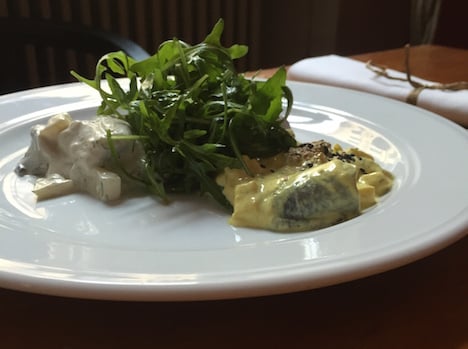FOOD AND DRINK
Ash Wednesday treats for the hard of herring
The Local's food writer and consultant chef, Gaz Smith, looks into your best options for the start of Heringsschmaus on Ash Wednesday.
Published: 17 February 2015 14:00 CET

Photo: Gaz Smith
Look, I´m not gonna lie, going head to head with all the other Austrian food traditions, like crispy golden goose, sweet, potent sturm, earthy asparagus and pungent wild garlic, pickled raw fish isn´t exactly leading the pack.
Right ? Wrong!
At this time of year, you can passive aggressively poke the Catholic church in the eye and thoroughly enjoy eating this delicacy. Like most great dishes, it started as a peasant’s food, but has now firmly staked its claim as one of the most respected festival dishes going, and it’s good for you too (if you ignore the calories and focus on the omega fatty oils and vitamins.)
I´ve been converted, and it’s about knowing where to go, and in a landlocked country, it ain’t easy knowing where to go, and if you get a bad one, you´re not going to rush back for seconds.
Another great thing, and perhaps most importantly, is that the locals constantly recommend it as a great hangover cure : Salt, Fish, Mayo, Bread and Schnapps, what could go wrong?
My fish supplier, Lisa, tells me that it’s getting more popular every year, and that it signifies the first of the 40 day fasting period we know as Lent, which means Austrians can “Fressen & Saufen” for the last time without the guilt of meat.
The days of seeing it as a form of punishment are long gone and it has become one of the highlights of the culinary year.
I know from experience that the restaurants offering the biggest choice are not necessary the best options. We tried a few places which were recommended by my fellow chef friends, and then we went fishing for the best.
Peter Neurath, owner of Tancredi, was recommended by a good few people as a great place to start, and his restaurant is where other chefs go to eat on their days off.
So we went to ask him, and, like a gentleman, he demonstrated it for us in three ways: the classic herring with granny smith apples, beetroot and horseradish, another version with apples, celery and spring onion and a third option with curried aioli, apples and spring onion.
All three were delicious, and cured me of the few pints the night before — the locals are right!
Restaurant Tancredi, Große Neugassse 5 / Eingang Rubensgasse 2,
1040 Wien (www.tancredi.at)
Other notable suggestions were
Bernhauers, Pfeilgasse 2, 1080 Wien (http://www.bernhauers.at)
Meixners gastwirtschaft Buchengasse 64, 1100, Wien (www.meixners-gastwirtschaft.at/)
Amon, Schlacthausgasse 13, 1030, Wien (www.amon.at)
Schreiners gastwirtschaft, Westbahnstrasse 42. 1070, Wien (www.schreiners.cc)
Well that’s me sorted for Ash Wednesday, and now I just have to pretend that Lent doesn’t exist.
Mahlzeit !
Gaz Smith is head chef at popular Irish restaurant and pub O’Connors.
Url copied to clipboard!


 Please whitelist us to continue reading.
Please whitelist us to continue reading.
Member comments